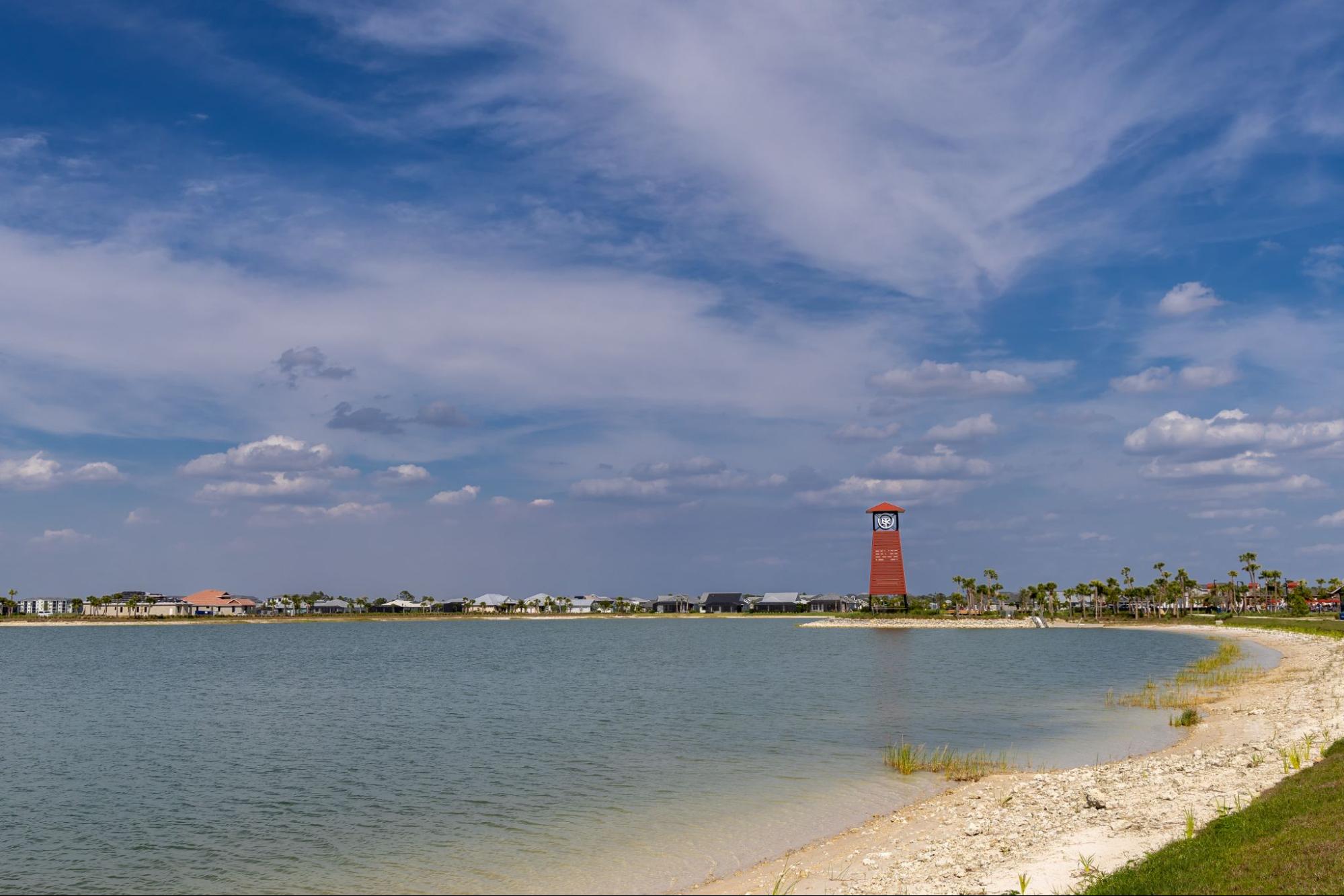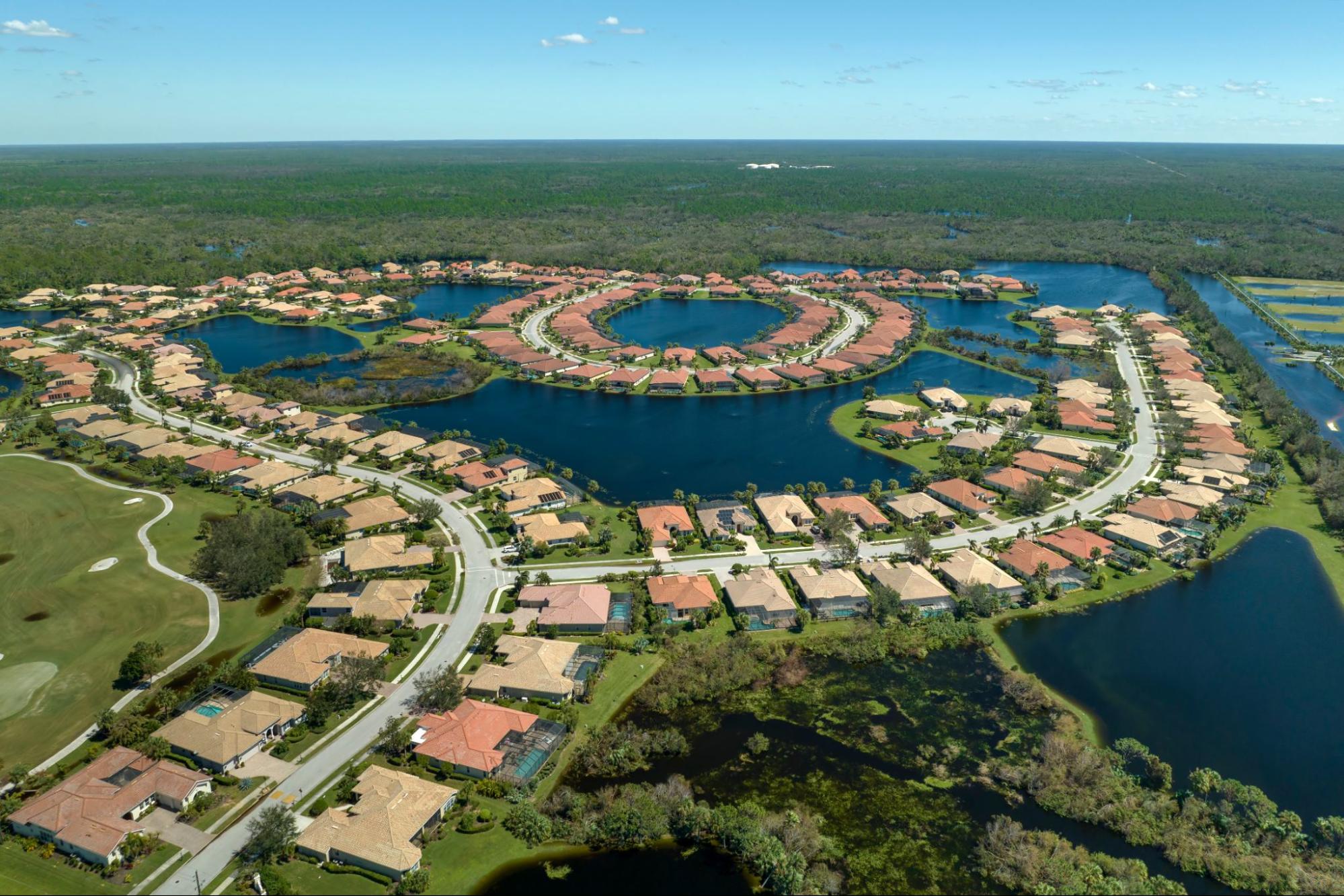How Babcock Ranch Avoids Flooding in Hurricane-Prone FL
Babcock Ranch avoids flooding through a system of elevated design, smart stormwater lakes, preserved wetlands, and layered drainage that works with natural terrain, not against it.
How Babcock Ranch Avoids Flooding: Key Takeaways Up Front
Babcock Ranch was purpose-built to handle Florida’s toughest storms.
Located 20 miles inland on high ground, it uses smart design and natural systems to manage water before, during, and after hurricanes. Here’s how it works:
- Strategic Elevation: Homes, roads, and buildings are tiered by height to direct water away from living areas.
- “Bowl” Lakes & Pipes: Artificial lakes sit lower than homes and are connected by underground pipes that shift overflow.
- Manual Storm Prep: Lakes can be drained ahead of storms to add storage space for heavy rain.
- Wetlands Over Pumps: Water drains into protected wetlands, not just pipes, slowing runoff and reducing pressure on infrastructure.
- Redundant Flow Paths: If one area floods, water is rerouted automatically through connected systems.
- Power + Internet Stays On: With solar energy and buried lines, utilities remain stable during storms.
These aren’t just one-off features.
They’re part of a unified system that’s kept homes dry while others around them flooded.
And if you’re wondering whether this approach can work in other communities, or what happens if the tech fails, those are the kinds of real questions we’ll get into next.
Inside Babcock Ranch: Florida’s Flood-Resilient Town That’s Defying the Odds

While many communities brace for floods with sandbags and pumps, Babcock Ranch took a different path, one that started long before the first home was built.
This master-planned town in Southwest Florida was designed to work with water, not against it. The result?
A community that stayed dry during Hurricane Ian, while others nearby were underwater.
1. Smart Planning Meets Natural Systems
Babcock Ranch wasn’t just built in a safe location, it was built with nature in mind. Every design choice reflects a deep respect for topography, storm behavior, and native ecosystems.
- Located 20 miles inland, it benefits from a natural buffer against storm surge.
- Elevation ranges from 12 to 38 feet above sea level.
- Historic floodplains were avoided to preserve natural drainage zones.
- Wetlands were expanded to absorb and slow runoff during storms.
By aligning development with natural water systems, Babcock turned Florida’s flood-prone terrain into an advantage rather than a liability.
2. “Bowl System” Engineering Explained
Think of it like a series of cereal bowls under your entire neighborhood.
Babcock Ranch’s water management system mimics nature using a clever “bowl” design. Instead of flat grades and concrete drains, it uses elevation and gravity to its benefit.
- Artificial lakes act as low points to collect runoff.
- Homes sit at higher elevations than lakes and roads.
- Underground pipes connect lakes to redirect overflow.
- Roads are designed to flood temporarily and steer water away.
This system ensures water always has a place to go, and it’s not into people’s homes. It’s a passive yet powerful form of flood defense that continues to perform under pressure.
3. Proactive Water Management Before Storms
One of Babcock’s smartest advantages is its ability to manage water levels before a drop of rain falls. Operators don’t just react, they prepare.
- Lakes can be drained ahead of storms to create storage.
- Water is slowed down, not forced out, for natural absorption.
- Overflow routes lead into wetlands, not downstream systems.
- One main ditch moves excess water off-site gradually.
By giving water room and time to move, Babcock avoids the all-too-common trap of rushing stormwater downstream and creating new flood zones.
4. Strategic Elevation Makes Every Inch Count
Elevation isn’t just about being “higher”, it’s about being strategically higher.
Babcock uses carefully tiered grading across homes, roads, and infrastructure to direct water exactly where it should go.
- Local roads are raised 3.5 feet for subtle runoff control.
- Major roads are elevated 4.5 feet for post-storm access.
- Homes sit 5 feet above grade, exceeding FEMA’s base elevation.
- Grocery stores and offices are elevated 6+ feet to stay operational.
This tiered approach makes it possible to flood less important surfaces, like roads, while ensuring homes and critical services stay dry and functional.
This level of flood protection isn’t the result of one clever feature, it’s the outcome of deep planning, smart elevation, and respect for how water really behaves.
But what makes Babcock Ranch truly different is that this thinking started before the first home was ever built.
Why It Works: Resilience That Starts Before the First Brick
Flood resilience isn’t something you can bolt on after the fact.
At Babcock Ranch, it was embedded in the foundation, literally.
From the earliest planning stages, the design team took a ground-up approach rooted in local terrain, natural flow patterns, and future-proofing every inch of infrastructure.
1. Hydrology Modeling That Looks Back to Move Forward
Before breaking ground, engineers studied how water moved across the land long before modern development ever reached the area.
- Historical maps from the 1940s–50s showed original drainage paths.
- Natural flowways were preserved rather than paved over.
- Roads, lakes, and homes were designed around these water paths.
By preserving how water naturally moved, Babcock minimized risk without overengineering. Sometimes, looking back is the smartest way forward.
2. Refusing to Build on Nature’s Exit Routes
In most developments, high-value land gets prioritized, even in flood zones. Babcock chose safety instead.
- No homes were built on natural water flowways.
- Wetlands and low-lying areas were left intact.
- Flood safety took priority over short-term profit.
That philosophy shaped every decision: let nature guide the layout, and protect the investment.
3. Repurposed Mining Pits Became Stormwater Lakes
Old mining pits weren’t hidden, they were transformed into key flood infrastructure.
- Dozens of pits were reshaped into connected lakes.
- These lakes store rainfall and stormwater naturally.
- No new excavation was needed, just smart reuse.
By using what the land already offered, Babcock increased capacity and cut impact.
4. No Imported Fill Dirt: Elevation From Within
Instead of importing truckloads of soil, the community built up from the inside.
- On-site soil from drained lakes was reused for elevation.
- This reduced hauling costs, emissions, and disruption.
- The result: a higher, safer town built with local material.
It’s efficient, sustainable, and deeply rooted in the land’s own character.
5. Built-In Redundancy: A Backup for Every Drop
No system is perfect, so Babcock planned for failure points before they happened.
- Lakes are linked by pipes that redirect overflow.
- If one fills up, others take over instantly.
- Water always has a place to go, by design.
Even under pressure, the system keeps working. That’s resilience built into every layer.
Every detail, from buried lakes to elevated lots, was planned with one goal: keep water under control, no matter what.
But the true success of Babcock’s design isn’t just in the engineering, it’s in how it performs when real people are living through the storm.
Helpful Resource → How to Build a Beach House That Lasts
Living in a Flood-Ready Community

Flood protection isn’t just about avoiding disaster, it’s about building a life with fewer disruptions and more confidence.
At Babcock Ranch, resilience is part of everyday living.
1. Life Keeps Moving During the Storm
When Hurricane Ian hit, Babcock Ranch didn’t skip a beat. Power stayed on thanks to buried lines and solar backup. Internet and sewer systems kept working.
No evacuations, no shelters needed, just neighbors helping neighbors, offering meals and support when it mattered most.
2. Homes Built to Hold Their Value
Homes here regularly sell for over $1 million, and for good reason.
Elevated foundations, smart water systems, and renewable energy make them stand out. Buyers see more than a house, they see long-term peace of mind.
While insurance incentives are still catching up, the value of living in a storm-ready home is already clear.
Some still ask: what happens if the tech goes offline?
It’s a fair question. But the system is layered with backups to keep water moving even when conditions aren’t ideal.
At Babcock Ranch, resilience isn’t just a feature, it’s a lifestyle.
From daily comfort to long-term confidence, the community proves that smart design can deliver both safety and lasting value, even when the next storm hits.
Babcock Ranch in Built for the Long Haul
What sets Babcock Ranch apart isn’t just the smart ponds or buried power lines, it’s the mindset behind them.
From day one, developers chose long-term resilience over short-term gain, often sacrificing profitable build areas to protect natural drainage paths.
It’s not one feature that makes the town flood-resistant, it’s a layered system of smart decisions working together.
Elevation, water flow, redundancy, and natural integration all play a role.
Babcock Ranch isn’t just avoiding floods. It’s setting a new standard for how Florida, and other flood-prone regions, can build for the future.
If you’re looking to build or buy a home that’s designed to withstand Florida’s toughest storms, Tri-Town Construction brings that same long-term resilience mindset to every project.
Reach out today to start building smarter, safer, and stronger.


